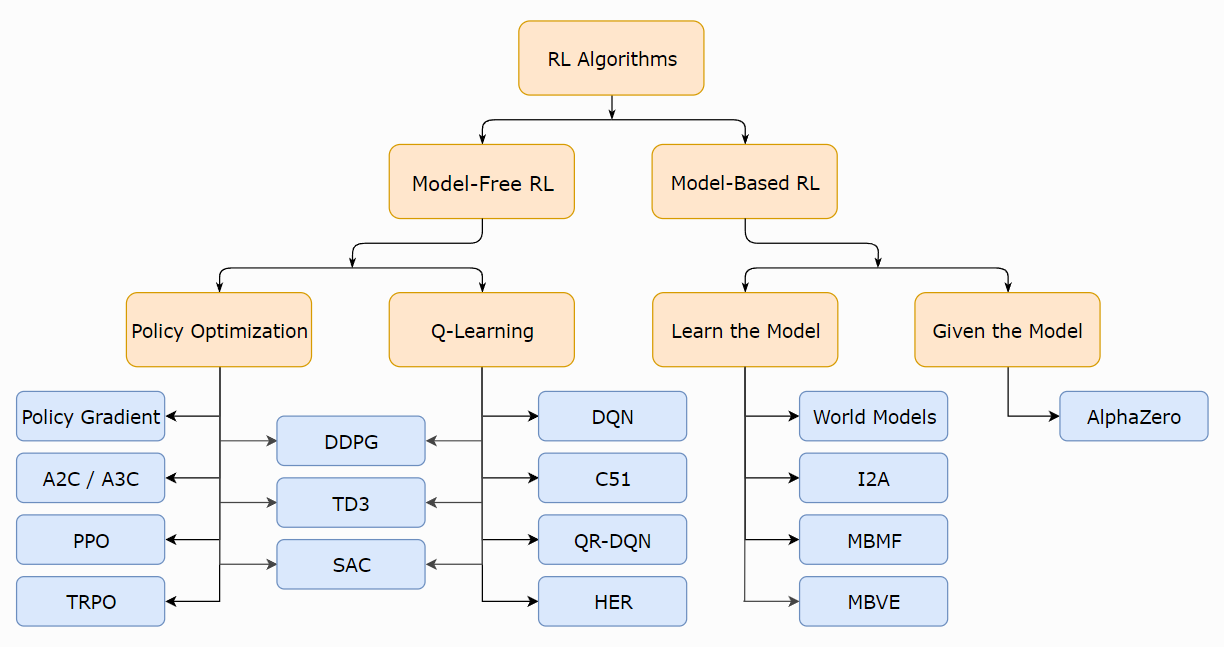type
status
date
slug
summary
tags
category
icon
password
Explaining the principles behind the MC and TD-Lambda RL Algorithm.
Introduction
Taxonomy of RL algorithms
The figure below provides a general, though not all-encompassing, classification of deep RL algorithm designs.

The Monte-Carlo and Temporal-Difference algorithms we will introduce in this article are both typical model-free approaches.
Monte-Carlo Algorithm
For episode , the return is defined as the total discounted reward: Our objective is to learn the value function, which is the expected return
Monte-Carlo approaches with the empirical mean sampled episode returns.
To evaluate state , we maintain the arrays and :
- The first/every time-step that state is visited in an episode,
increment counter
- Increment total return
- Value is estimated by mean return
- By law of large numbers, as

This process can also be done incrementally:
For each state with return
Often it could be useful to replace with for non-stationary problems.
TD Algorithm
Instead of the actual return , Update value toward (biased) estimated return:
- is called the target
- is called the error

is not dependent on the final outcome.
Dynamic Programming Backup
prioritizes exploration in stead of exploitation.

Certainty Equivalence
for the observed episodes:
converges to solution of the that best fits the data.
Its estimators are:
exploits Markov property, and are usually more efficient in Markov environments.
Bootstrapping and Sampling
ㅤ | Bootstrapping | Sampling |
n-Step TD
Dene the n-step return:
n-step :
TD(lambda)
Lambda return and forward view
We combine all using weight to compute the , and formulate the forward-view of accordingly:
It is worth noting that the weights decay by a factor of , and

The weighting function can be illustrated below:

The weights assigned to the terminal point is the sum
Eligibility Traces
To assign a state’s eligibility with respect to its outcome, we consider its frequency and recency heuristics by writing:

e.g. for episode , the eligibility traces are:
Backward view
We keep an eligibility trace for every state . For each time step, broadcast the backwards:

- When , only current state is updated.
- When , total update for is the same as . Therefore, is roughly equivalent to every-visit .
Theorem
The sum of offline updates is identical for forward-view and backward-view
Error telescoping
When , sum of telescopes into ;
For general , TD errors also telescope to , :
Consider an episode where is visited once at time-step
Online and offline updates
Offline updates
- Updates are accumulated within episode
- but applied in batch at the end of episode
Online updates
- updates are applied online at each step within episode
- Forward and backward-view are slightly different
- Exact online achieves perfect equivalence
here indicates equivalence in total update at end of episode.
References
[3] Berkeley cs285
- Author:VernonWu
- URL:https://vernonwu.com/article/TD_RL
- Copyright:All articles in this blog, except for special statements, adopt BY-NC-SA agreement. Please indicate the source!
Relate Posts